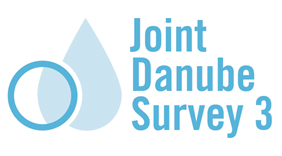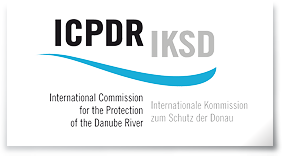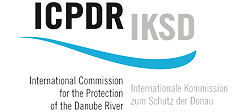News
Vienna, 22 March 2015. Just in time for World Water Day 2015, the Final Scientific Report was published today. You can download the report in the newly created results section of this website.
Vienna, 24 February 2015. The technical report with all findings of JDS3 is in the process of being finalised. All results will be made available on this website as well as on ICPDR.org in early March. Stay tuned, the publication will also be announced here in the blog.

Capturing the JDS3 spirit: UFZ staff photographer André Künzelmann took this picture near the Iron Gate Gorge.
Bremen/Leipzig, 24 September 2014. The photographer André Künzelmann was awarded the “Deutscher Preis für Wissenschaftsfotografie”, a prestigious award for science photography for a photo essay on the Joint Danube Survey 3. The German science photography award is given annually by the magazine “bild der wissenschaft” and the press office Brendel. The photo essay “Joint Danube Survey 3” was done by André Künzelmann, a staff photographer of the Helmholtz Centre for Environmental Research (UFZ), in close cooperation with scientists around Werner Brack last summer during the sampling work of JDS3.
“The photographer has succeeded in capturing the many aspects of scientific work in this essay: plants, dead fish, plastic buckets and Wellington boots are equally convincing ingredients of research as the sophisticated laboratory on board for analysing samples. The composition of the photos invites the observer to learn more about the river expedition”, say the judges of the photo competition.
„I am delighted about this award, especially as this essay was a particular logistic challenge”, says Mr Künzelmann, himself a meteorologist by training, who specialised in science photography during the past decade. “Effectively, I had only two days to get an overview on site, and I did not know the crew beforehand. With the tight schedule of the scientists, where every moment was planned out, additional questions and wishes from an ‘outside’ like me requires a degree of mutual understanding. As a photographer, you are under constant pressures in such a situation, because you don’t want to miss the best moments and you may have to catch them under difficult light situations.”
The Joint Danube Survey is the world’s largest river expedition. It catalyses international cooperation from the 14 main Danube Basin countries and the European Commission, united through the ICPDR. A Joint Danube Survey is carried out only once every six years – JDS1 was in 200,1 JDS2 in 2007, JDS3 in 2013 with results to be published soon.
Leipzig, 4 February 2014. The Project "SOLUTIONS" aims to develop new approaches for emerging pollutants in european water resources in close dialogue with stakeholders. To that end, the project develops the conceptual framework as well as monitoring and modelling tools for the identification, assessment and prioritisation of hazardous pollutants and mixtures in European water resources and suggest river basin specific pollutants. Concepts and tools will be demonstrated in large trans-european case studies. The knowledge base and decision support for the abatement of risks will be provided.
SOLUTIONS performed its first large scale sampling campaign together with the Joint Danube Survey 3 taking water, sediment, invertebrate and fish samples at 68 sites along a river stretch of 2375 km from Regensburg in Germany to the Danube Delta in Romania und Ukraine.
Presently, all these samples are analysed for more than 400 target chemicals, for unknown contaminants as well as for potential adverse effects to aquatic organisms and humans. You can learn more about the project at the official SOLUTIONS website. The full version of the website will be launched later this year and we will announce it here in the blog. As part of the project's work in the frame of JDS3, a video clip was produced which you can already watch on the website (or via YouTube as below).
Vienna, 23 January 2014. The Joint Danube Survey 3 is long over, right? Wrong! Whilst the sampling has concluded last autumn, the analysis of the samples is now in full gear.
Meanwhile, you can enjoy some great coverage of the JDS3 sampling expedition, provided by Kerry Skyring who accopanied the ships in Austria for Deutsche Welle. For an article to go with the broadcast, note this page.
Vienna, 20 December 2013. Issue 3/14 of Danube Watch has been published and is available in print as well as online at icpdr.org. The issue has a focus on the "UN International Year of Water Cooperation" and features not only an editorial of UN Secretary General Ban Ki-moon, it also covers the work of the crew on the ships of Joint Danube Survey 3. Read Igor Liska's "Credit to the Crew" here.
.jpg)
Colourful as an autum day: impressions from JDS3 in Romania, captured by Bogdan Agiu.
Bucharest, 18 October 2013. With Bogdan Agiu, Romania had an avid photographer as part of its national team of scientists to accompany parts of JDS3. Mr Agiu has now kindly provided us with pictures from the late state of the JDS3 sampling, which you can view in our Romania gallery.
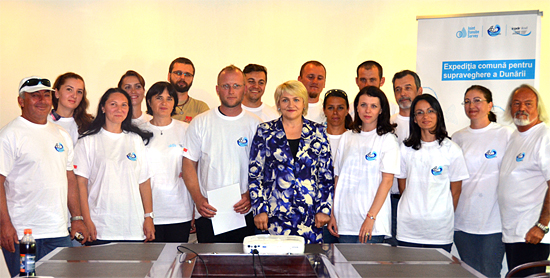
Minister of the Environment Lucia Ana Varga at the public event in Tulcea.
Tulcea, 13 October 2013. While JDS3 sampling was finished two weeks ago, the analysis is getting into full gear. Throughout the Danube River Basin, scientists that were eagerly waiting for samples are now working on them. Meanwhile, pictures from the public event in Tulcea were received from Romania. The closing event, which took place on 26 September, was chaired by Minister of the Environment Lucia Ana Varga. You can find more pictures in our Romania photo gallery.
Vienna, 30 September 2013. The international team of scientists of the “Joint Danube Survey” river expedition has completed its sampling. Now a period of intensive data analysis follows as part of the biggest river expedition worldwide in 2013.
For the weeks and months to come, scientists will now analyse the samples of water and other data that was collected from three research vessels. Analyses will now look at animals and plants; chemical substances and sediment, larger fish as well as microscopic bacteria. Laboratories across Europe will carry out parts of these analyses, with complete results due to be published next autumn. The International Commission for the Protection of the Danube River (ICPDR) coordinates the project.
"The Joint Danube Survey has drawn time, money and know-how from 14 Danube countries. It is a demonstration on how cooperation in water management can add value for every party involved", says ICPDR President Ermina Salkicevic-Dizdarevic. "An effort as big as JDS3 could not be undertaken by any single Danube country alone. United, however, the ICPDR members realised this river expedition and made it an outstanding success."
This success was also reflected in public events: in nine cities along the Danube, press conferences and outreach activities were organized, resulting in wide-spread media attention and enthusiastic crowds welcoming the JDS3 ships at the Danube river banks from Regensburg in Germany to the Danube Delta. This interest helps the ICPDR to promote the scientific objectives of the JDS3 among a broader audience, as well as specialists such as researchers working in the field of freshwater ecology. Most importantly, however, the findings will feed directly into the so-called “Danube River Basin Management Plan”, a work schedule which addresses environmental problems related to water.
"JDS3 will contribute data to many scientific publications that we expect for the coming months", says Ivan Zavadsky, ICPDR Executive Secretary. "For us, however, the policy side is equally important. JDS3 is essential for putting the management plan for the Danube River Basin on a sound scientific foundation." This management plan is developed by experts from all ICPDR members until 2015 and will be implemented over a period of six years thereafter.
The research of the Joint Danube Survey is conducted by an international team of 28 scientists, who took samples along 2,376 kilometres through 10 countries. Now the samples are being analysed. The JDS is carried out every six years – JDS1 was in 2001 and JDS2 in 2007. Corporate partners, such as Coca-Cola and Donauchemie, support the effort.
Vilkovo, 24. September 2013. Despite of the having a long and hard day yesterday, the expedition started its work very early at 05:30. Ukrainian specialists joined to the sampling at 18 river km of the Danube (near Vilkovo). The Ukrainian experts learned a lot regarding the use of new equipment and methodology during this sampling. It is worth of mentioning that for Ukraine implementation of the EU Water Framework Directive will become obligatory (from voluntary) like it is now, if in the end of November in the third Eastern partnership Summit in Vilnius, Lithuania the Association Agreement Ukraine-EU will be signed.
After this, on the kind invitation of the JDS 3 team, all participants had a symbolic trip to 0 km of the Danube, where the Danube enters the Black Sea. People said that 0 km is a special magic place which can implement different wishes of the people who attended it, so we all hope that these wishes will come true for all the participants and Danube itself!
Vilkovo, 24. September 2013. We received new blog entry from our colleagues from Umweltbundesamt (Environment Agency Austria) about Sediments. Full text in german you can read here.
.jpg)
Press conference at the public event in Vilkovo, Ukraine.

Journalists had a chance to meet JDS3 Core Team members and to ask questions.
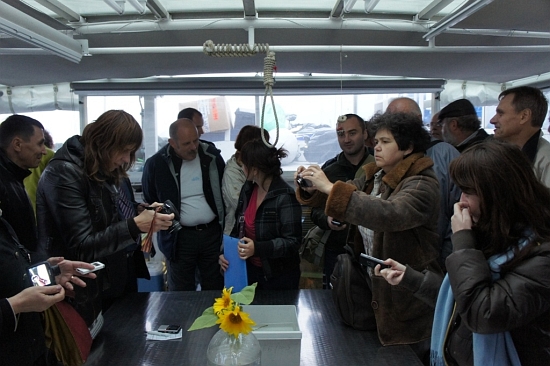
Trip around the ships gave a chance journalists and visitors to find out more how look the life and work on board.
Good spirit among the members of the JDS3 Core Team.
Vilkovo, 23. September 2013. Although the JDS3 ships were delayed, a lot of people (national and regional authorities, media, local citizens, children) waited for them in harbor. The press-event started from children performance in several Danube language and symbolic handing over of the bread by the oldest citizen of Vilkovo. The press-conference took place on the open air near the harbor. The following speakers made presentations at the press-conference:
- Mr. Mykola Dyadzin, Major of Vilkovo
- Mr. Ivan Zavadsky, Executive Secretary of ICPDR
- Mr. Mykhaylo Tomakhin, Director of the Department of Protection of Nature Resources, Deputy Head of Ukrainian Delegation to ICPDR, Ministry of Ecology and Natural Resources of Ukraine
- Mr. Alexei Chunarev, Deputy Head of State Water Agency of Ukraine
- Mr. Bela Csani, JDS 3 Team Leader
- Mr. Jaroslav Slobodnik, JDs 3 Coordinator
- Mr. Andriy Bublyk, Coca-Cola beverages, Ukraine
- Mr. Alexei Iarochevitch, EU project “Complementary support to the Ministry of Ecology and Natural Resources of Ukraine in Sector Budget support implementation”.
As a side event, the local children presented their ecological action on cleaning of Danube river bank.
The press-conference was attended by many journalists, who represented 17 media sources. A lot of questions were asked before the press-conference (while waiting for the ships), and even more during the visit to JDS 3 expedition vessels. People listened with excitement the speech of Mr. Bela Csaniy regarding the biodiversity of the Danube, rare and invasive species, methods of sampling. The method of electrofishing also raised a lot of questions.
The evening was finished with dinner on kind invitation from Coca-Cola Beverages, Ukraine with traditional local performance.

Radoslav Cuban measuring the water level characteristics.
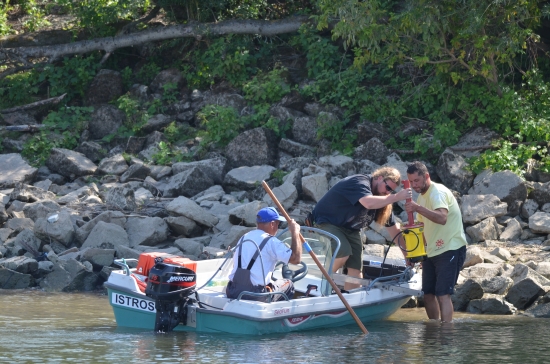
Peter Matok with Jan Busovsky preparing an ACDP device.
Reni, 23. September 2013. The hydromorphological characteristics of a river
“Hydromorphology”, as defined by the WFD, is the physical characteristics of the shape, the boundaries and the content of a water body. To have good ecology, the Danube and its tributaries must, for example, serve as habitats for characteristic animals and plants, and therefore provide typical structures and hydrological characteristics required for such habitats.
The survey and assessment of the hydromorphology of the Danube was a completely new task for the previous JDS2, and the efforts during JDS3 are to build on the existing knowledge and to provide a more comprehensive picture on the river habitats.
The JDS3 hydromorphological team consists of Peter Matok and Jan Busovsky alternating with Radoslav Cuban. Katarina Holubova together with Ulrich Schwarz have prepared the ambitious program of the hydromorphological survey.
The continuous longitudinal survey of 10 rkm stretches is being carried out during JDS3 to obtain an overview of the hydromorphological conditions of the Danube from Kelheim (rkm 2,415) to the Danube Delta (rkm 0). It includes an individual assessment of the channel, banks and floodplains according to CEN Standards over the entire Danube stretch. In addition, the hydromorphological characterization of each JDS3 site is performed in support of the interpretation of biological results. The hydromorphological monitoring includes also the measurement of the water slope, water level fluctuation, river discharge, channel geometry, flow velocity as well as bottom and suspended sediments analysis.
The slope of the river water level is one of the key hydraulic characteristics directly connected with the river processes. Water level slope reflects the current flow conditions (flow regime), it is an indicator of sediment movement (sheer stress) and it contributes to determination of channel forming processes (erosion, deposition) which are essential for biota creating the habitat diversity. Water level fluctuation indicates changes in discharge and flow regime in time. This is particularly relevant and important information for the ecological quality elements as it clearly documents the range of discharge changes and possible effects of hydro-peaking.
Flow velocity and current discharge conditions are of high importance for the assessment of both biotic and abiotic parameters. Flow pattern and discharge values enable better hydromorphological characterization of a sampling site creating a basis for identification of channel forming processes (sediment transport & erosion/deposition). ADCP measurements that provide high quality spatial data covering total discharge, velocity, channel geometry (width, depth/water level) over the particular cross section are also very helpful for the assessment of biological quality elements.
The river bed material is collected at each sampling site covering the main river channel, tributary area and channel bars supposing they occurred in the site. Physical characteristics of the river bed material and grain size distribution are analysed along the Danube and used for a detailed morphological assessment of the sampling sites. The data will form a basis for understanding and clarification of the river channel behaviour in relation to its biotic colonisation.

The fish team in Ruse.
Reni, 23. September 2013. Our fish team has many successes during this survey, some of them you can see in our updated fish photo gallery. But it was not always so smooth. Bad weather, broken engine and sand dune in the middle of the river that trapped the fish boat, were only few of the challenges for the fish team during this survey. In the video clip above you can see how the fish team had to improvise, to release the trapped ship from the sand dune.
Oltenita, 19. September 2013. As the JDS3 Team sample at the sampling site 60 (Chiciu/Silistra), you can read blog entry from our colleagues from DanubeParks about monitoring of Little-ringed Plovers and Sand Martins, already mentioned in our news blog on 20. August 2013.
JDS 3 / DANUBEPARKS Monitoring
This year, the JDS3 Team received an additional contribution from the DANUBEPARKS Network – The Danube River Network of Protected Areas. With their monitoring of Little-ringed Plover and Sand Martin, they monitor the existence and development of dynamic river sections. River dynamics are an integral part of the river ecosystem – all the habitats in and around a river depend on rising and falling water levels, and the sedimentation and erosion processes taking place. An example of what is produced by this are sand and gravel banks or islands – breeding habitat for Little-ringed Plover – and steep river slopes washed out by the water – where Sand Martins have their breeding holes.

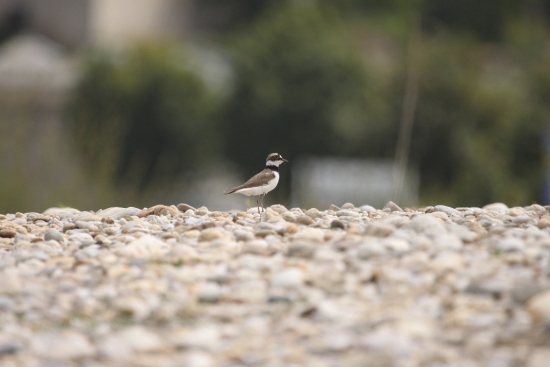
Ringed Plover (©Nationalpark Donau-Auen/Kern).
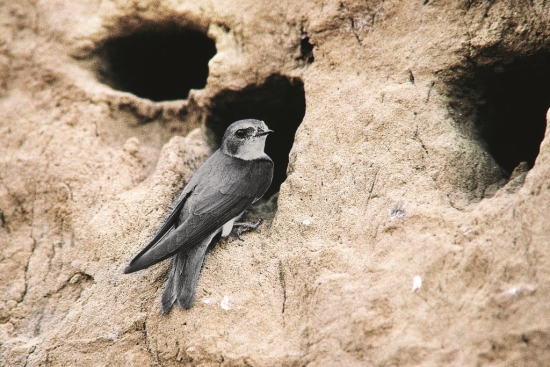
Sand Martin (©Nationalpark Donau-Auen/ BuchnerB ).
The monitoring was done once already in spring 2011, with rather low water level and therefore perfect conditions for the birds to breed and the scientists to detect them. This year, everything is different: The huge flood at the beginning of June somehow crossed our plans: We needed to delay the second round of monitoring to the end of June, in some parts even to July. As the water level was high during both monitoring rounds – definitely not the best breeding conditions for the two bird species – it will be interesting to compare the results of both years!
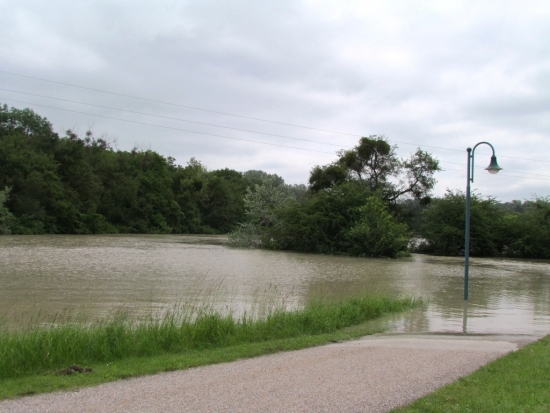
(©Nationalpark Donau-Auen/ Dorn)
Matthias Schmidt, scientific coordinator of the Danube-wide Monitoring at BirdLife Austria and field worker in the German- Austrian section, about his experience this year: “At the end of May, we had to stop our survey in the free flowing Danube section between Straubing and Vilshofen, due to the rising waters. At this time we didn´t know yet that this was just the beginning of a huge flood which devastated vast areas along the Danube. Our thoughts were with all the people that were in danger or who lost everything, but we also feared about our boat: It was docked in Deggendorf, and when we saw pictures of the broken dam on TV, we didn´t expect to see it again. We were lucky enough – coming back end of July, our boat was still swimming and had no damage at all!”
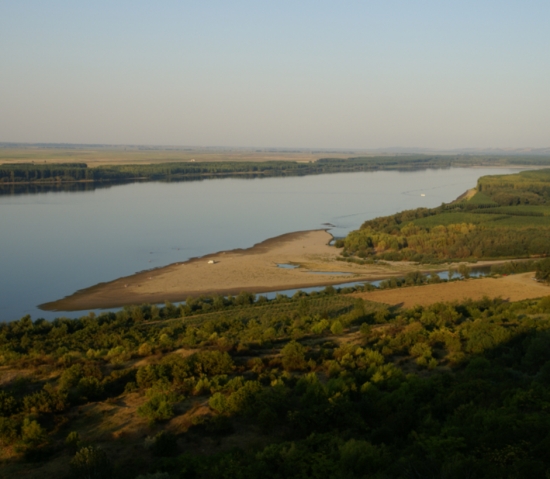
(©Persina Nature Park)

View on the city and port Ruse, Bulgaria.
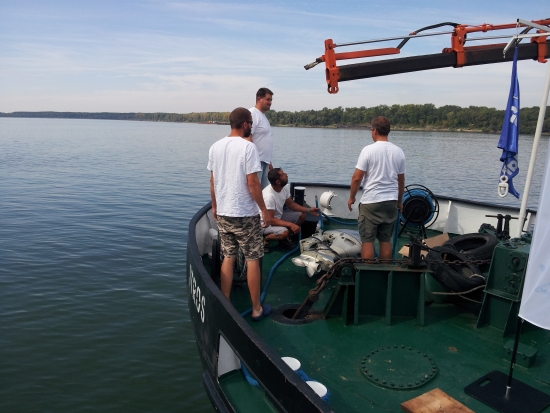
Demonstrations of the equipment to journalists.
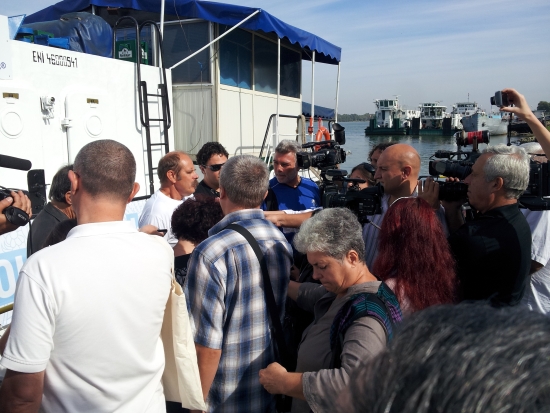
Bela Csanyi, JDS3 Core Team Leader, giving the interview at the public event in Ruse.
Ruse, 17. September 2013. We are delivering first impressions from the public event in Ruse, Bulgaria.
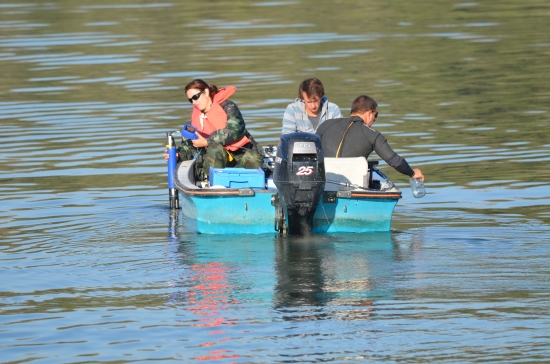
Florentina Dumitrache (on the left) measuring physico-chemical parameters directly in the river.
Ruse, 17. September 2013. While scientists enjoy their deserved free-afternoon in the Ruse, we bring you more interesting stories. In the article bellow you can read about on-board physico-chemical analysis.
The on-board physico-chemical analysis (pH, water temperature, conductivity and dissolved oxygen) is carried out by Florentina Dumitrache directly in the river using a motor-boat. The Standard Operational Procedures (SOPs) based on international standardised methods are applied for in-situ measurements, using portable YSI multiparameter sonde.
At each sampling point all the parameters are measured in a transversal profile (left bank, middle and right bank) while for most of the tributaries, (except of Sava, Tisa and Drava) only middle of the river is monitored.
The concentration profile of dissolved oxygen in the Danube River and in some tributaries is shown in figures 1 and 2.
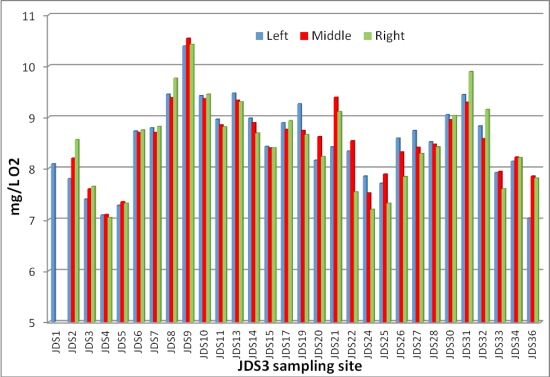
Figure 1: Variation of dissoved oxygen (concentration) in Danube River until sampling site no.36 during JDS3.
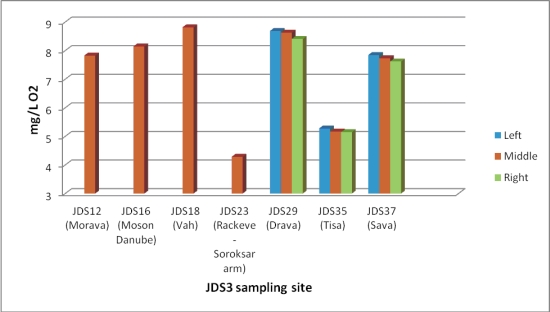
Figure 2: Variation of dissoved oxygen (concentration) in some tributaries during JDS 3.
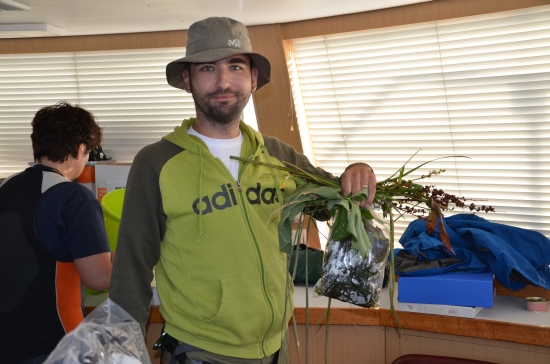
Satisfaction after successfull collecting macrophyte species. (Igor Stankovic)
Ruse, 17. September 2013. Green wonders of the Danube River
Macrophytes are the term that comprises all water plants, including macroalgae, mosses, water ferns and angiosperms (Fig. 1). All of them are represented in the Danube River, but community composition changes through the Danube stretch.

Figure 1. a) Moss - Fontinalis antipyretica Hedw.; b) Fern – Azolla filiculoides Lamarck;
c) Angiosperm – Potamogeton pectinatus L.; d) Macroalgae – Cladophora glomerata L.
Mosses dominate in upper sections where water is colder, fast flowing and river bed is covered with hard substrate which is more suitable surface for their inhabitation. In lower parts of the Danube stretch angiosperms starts to dominate because the river bed is covered with soft sediments, bank slope is more flattened and flow velocity is very low, sometimes even looks like standing water. Here we can find floating, emerged and submerged water plants (Fig. 2).
Macroalgae are present through all the Danube stretch, but often represented with different species. The stone worts genus Chara is characteristic for upper Rhithron section, while genus Nitellopsis and green filamentous macroalgae like Cladophora spp., Spirogyra spp. and Hydrodictyon reticulatum (L.) very often dominates in lower section with higher nutrient concentration.
According to the species composition, diversity, dominance of individual species and biomass, macrophytes are very good indicator for nutrient pollution and hydromorfological degradation and therefore very important biological element for monitoring of water quality. They also serve as food source and suitable habitat for many water organisms.

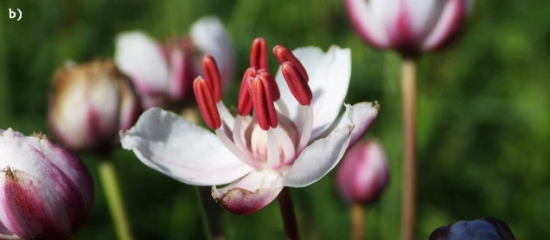
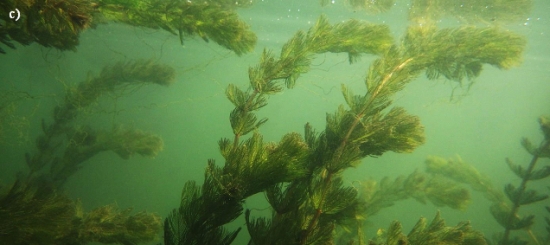
Figure 2. a) Floating Salvinia natans (L.) All. with Lemna spp.; b) Emerged Butomus umbellatus L.;
c) Submereged Myriophyllum spicatum L.
During JDS3 the analysis of macrophytes is being carried out by Igor Stankovic. At each sampling site he has to trawl three kilometres on both left and right bank to assess plants occurrence and diversity. Up to September 7th station downstream Velika Morava (1097 rkm) Igor Stankovic walked through 252 km banks of the Danube river and its tributaries to investigate water plants.

Martin Dokulil investigating the Danube phytoplankton.

Ulrich Donabaum (in the middle) collecting phytoplankton sample.
Ruse, 17. September 2013. The public event will take place today in Ruse ( Bulgaria ). Meanwhile, find out little more about Phytoplankton and how it is being analyzed in the article bellow.
Phytoplankton

Phytoplankton comprises free floating microscopic algae but also some macroscopic algae (e.g. Hydrodictyon, the water net). These organisms are photosynthetic active and utilize sunlight, water and carbon-dioxide to synthesize organic compounds. They are very important for water bodies as numerous organisms feed on them as well as for the production of oxygen. Given this importance, phytoplankton is part of the water-quality-assessment for the Water Framework Directive (WFD) and therefore is a prime variable analysed on board of the ships during JDS3.
The on-board analysis of the phytoplankton community includes qualitative analysis of the samples using light microscope, preparation of quantitative samples and chlorophyll filtration for analyses later in the laboratory. In addition, several parameters are measured such as Secchi-depth and physical-chemical variables which are important to understand algal composition and growth. The analysis of phytoplankton during JDS3 is being carried out by Martin Dokulil and Ulrich Donabaum.
The Phytoplankton community of the River Danube is dominated by centric diatoms. These are algae with radially symmetric cells consisting of two silica valves that appear as small cylinders in the microscope. The cells can be solitary or forming filaments. Besides the centric diatoms, coccal green algae and pennate diatoms characterise the Phytoplankton community. Especially coccal green algae turned out to be very divers during JDS3. Some of the regularly occurring genera are shown below:

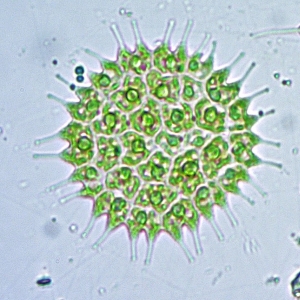
Scenedesmus Pediastrium
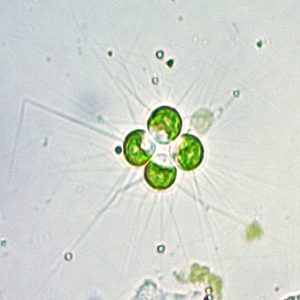
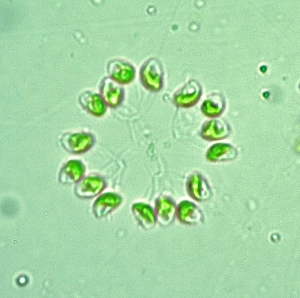
Micractinium Dictyosphaerium
Since the green photosynthetic pigment chlorophyll-a is present in all groups of algae, it is a good indicator of algal biomass. Analysis of chlorophyll-a therefore is an essential parameter indicating the quantity of algae present in the water. This in turn is a first approximation of water quality. Low values are mean low biomass and indicating good water quality, very high values are symptomatic for rather bad water quality.
Chlorophyll-a concentrations are measured using three different techniques during the JDS3 expedition down the Danube. One method uses a sensor fitted to a multiparameter sonde which is deployed from a small boat and measures chlorophyll concentration directly in the water. The highest concentrations so far have been observed in the middle stretch of the Danube (Figure 1). The influence of tributaries with high chlorophyll-a concentration and of tributaries with low concentration can be seen very well in the case of Vah (left-side tributary, high concentration) and Sava (right-side tributary, low concentration). Values below 10 µg L-1 indicate good water quality.
.jpg)
Fig. 1 Chlorophyll-a (Chl-a) of the River Danube between Medvedov and Banatska Palanka for left bank (L), middle of the river (M) and right bank (R). In the case of tributaries, e.g. Vah only on measuremnt in the middle was taken. Distances between sampling stations are equidistant and do not reflect the real distance in terms of river km.
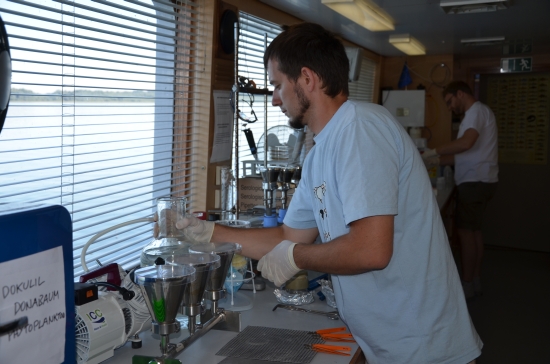
Stoimir Kolarevic and Stefan Jakwerth carrying out microbiological analysis on board of the Argus.

Georg Reischer in his search for dangerous microbes.
Svishtov, 16. September 2013. The microbiology team (Stoimir Kolarevic and Georg Reischer alternating with Stefan Jakwerth working on-board and Alexander Kirschner as a scientific leader on-shore) has prepared an update of the on-board report (see: Joint Danube Survey website report from Aug. 25).
The first microbiological results have shown, that the level of microbial faecal pollution of the Danube in Germany and Austria was generally little to moderate. However, left-middle-right sampling revealed two surprising spots of critical (Oberloiben, AT) to strong faecal pollution (Kelheim, DE) at the left river side. In both cases no reason for the observed increased pollution status was found so far. In addition, in the sample downstream Vienna (right) a critical E. coli concentration was found, which was expected due to the discharge of the large Vienna wastewater treatment plant and which lead to increased values in the Danube until the Austrian-Slovakian border.
Surprisingly, E. coli concentrations dropped significantly by one order of magnitude during Slovakia, despite the merging of the tributaries Morava and Moson Danube, both of which displayed much higher concentrations than the respective stretch of the Danube. E.coli concentrations remained at little to moderate levels in Hungary until Budapest. At sampling site “Downstream Budapest”, critical pollution levels were observed in the middle and at the right river side. Yet, E.coli concentrations were only slightly higher than the limit value for good bathing water quality, despite the fact that the effluent of the new wastewater treatment plant is situated in the middle of the Danube. However, 72 km downstream (Dunaföldvar), a massive increase in E.coli concentrations was observed only in the midstream sample, indicating that the wastewater plume of Budapest is measurable dozens of kilometres downstream. Obviously, no mixing of the midstream water with the left and right water masses has occurred.
After Dunaföldvar, moderate pollution levels could be observed until the mixing of the Drava tributary in Croatia, which lead to an increase of the E.coli concentrations at the right river side of the Danube to critical pollution levels. After Novi Sad (RS) pollution levels of the Danube were generally critical, and even reached the level of strong pollution after Belgrade. Both, Tisza and Sava tributaries, showed much lower E.coli concentrations than the Danube and the increase of microbial-faecal pollution in the Danube can be traced back to influence of the large cities in this stretch. After Pancevo, pollution levels started to decrease significantly.
You can download and read the full report as a PDF here.

Adsorption device for trapping hazardous substances which may be toxic even at extremely low concentrations.

Mary Craciun collecting suspended particulate matter.
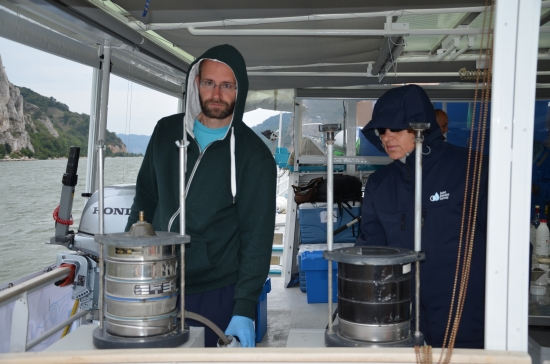
Peter Tarabek and Mary Craciun processing sediment samples.
Svishtov, 16 September 2013. Screening for invisible toxicants.
Complex mixtures of different pollutants can occur in river environment. Despite these substances are mostly present at extremely low concentrations they may affect a multitude of toxicity pathways in organisms, populations, and communities. The wide variety of potentially harmful chemicals challenges chemical monitoring and consequently there is a danger that adverse effects on aquatic communities and human health from unknown or unexpected chemicals and mixtures remain unrecognised. This problem is made worse by the fact that even very low quantities of pollutants, which are below detection limits of the standard analytical techniques, may have toxic effects.
To address this problem, which resembles searching for a needle in a haystack, the ICPDR embraced into JDS3 a comprehensive program of organic trace analysis. Next to a standard search for the hazardous substances in line with the EU legislation this program includes a number of novel approaches such as large volume sampling in combination with Effect Directed Analysis, passive sampling and non-target screening. In passive sampling a battery of passive samplers containing different sorbent materials is exposed to the Danube water for several days so that it can trap even the smallest amounts of chemical compounds occurring in a particular, several hundreds km long, reach of the Danube. As an alternative, up to 500 litres of Danube water is forced through a special adsorption device at selected sites catching the traces of hazardous substances which are then analysed by a set of bioassays, screened for a presence of hundreds of target substances and, going even further, efforts are made to identify the unknown pollutants by the most advanced analytical techniques.
These activities are being carried out in cooperation with the NORMAN network and with the FP7 project SOLUTIONS which is led by UFZ Leipzig, Germany. Among the principal partners are the University of Aachen, Germany, Water Research Institute, Bratislava, Environmental Institute, Kos, Slovak Republic, Masaryk University – RECETOX, Brno, Czech Republic and NIVA, Oslo, Norway.
Next to water samples also sediments and suspended particulate matter is collected for the trace analysis to obtain a complete picture about the contamination of a river system. It is obvious that such an ambitious programme requires very careful sampling and sample processing on board of the Argus. Any failure in collecting the appropriate sample or deviation from the standard operational procedure would result in misleading results. Therefore there was a need for very skilled and reliable experts being on board who would manage to do all the required workload at a high professional standard.
Mary Craciun operates the continuous flow centrifuge pumping several thousands of litres of river water at each Danube site to collect few hundreds of grams of the suspended solids, which are then distributed to various laboratories for further analysis. Together with Peter Tarabek, Mary also processes the collected sediments to obtain the necessary fraction suitable for subsequent analysis. The major activity of Peter is then to trap the needles in a haystack using the passive sampler and the mobile large-volume extraction unit containing a sequence of sorbents for the optimized extraction of a broad scale of contaminants. All these activities of Mary and Peter are carrying out on board are imperative for obtaining a very detailed information on the pollution of the Danube.
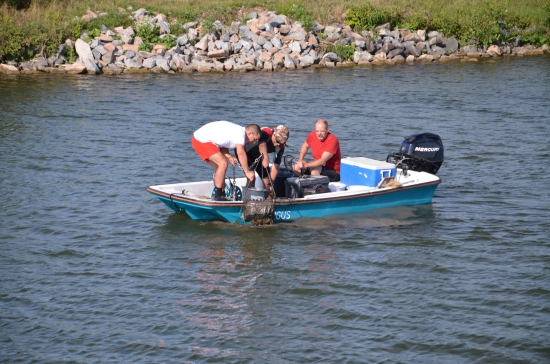
Sampling requires good cooperation, Bela Csanyi (on the right), Momir Paunovic (in the middle) and Jozsef Szekeres (on the left).

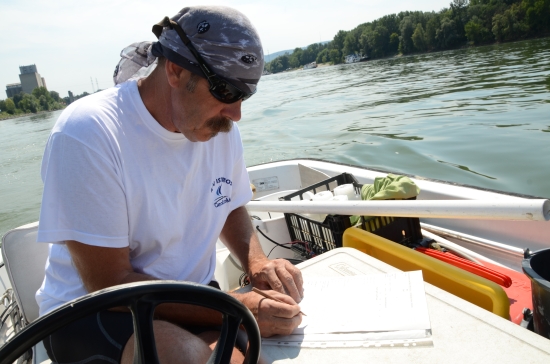
Team Leader Bela Csanyi.
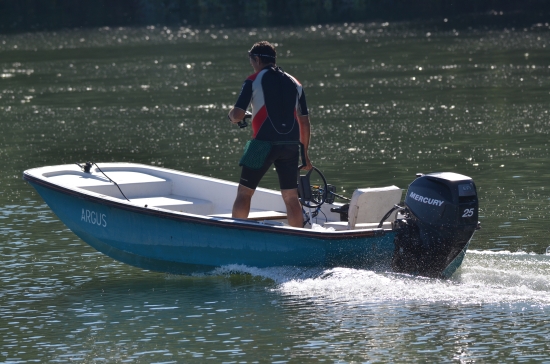
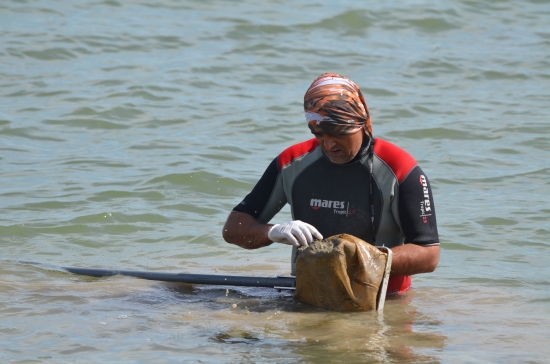
Deputy Team Leader Momir Paunovic.



The Sunset brings peace and relaxation...
Radujevac, 13 September 2013. Leading the team
The daily program of the JDS3 consists usually of a sampling campaign at a site and a transfer by ships between the sites (if there is not for other exciting activities such as checking out and checking in at various borders…). The detailed program for the Core Team, ships and small boats must be planned carefully because this is an essential prerequisite of a successful and time-efficient sampling. Such planning is quite complicated because the small boats and the Core Team members are allocated on both ships which sail separately but for the breakfast, lunch and dinner the Argus and Istros must get together to enable an access to the canteen for all.
It is also important that the cooperation of the Core Team at each site is well orchestrated. The detailed planning and management of daily activities is the task for the Core Team Leader Bela Csanyi and for his deputy Momir Paunovic. Despite both of them are leading experts in aquatic biology, their long-term experience with the Danube monitoring and with the Danube surveys (Bela Csanyi was the Core Team Leader during JDS2) made them the best candidates for leading the JDS3. Their responsibility for accomplishing the survey’s scientific program according to the plan requires their continuous coordination of the Core Team and the liaison with the ship captains about the navigational issues. They have to use an adaptive management approach to ensure the best accord between the navigation requirements and the scientific goals.
But it is not only the management issues Bela and Momir are busy with. They also drive the small boats during sampling to bring their colleagues to a particular sampling profile, they collect samples of water, sediment and biota at each site and also together with Jozsef Szekeres they carry out a cross-sectional dredging for benthic macroinvertebrates. Their standing enthusiasm is keeping the spirit of the Core Team high even when facing problems with instruments or engine failures or delays due to navigation circumstances.
And in the evening when the sunset calms down the hectic daily program of the Core Team the sound of Bela’s bagpipes is spreading over the Danube surface……
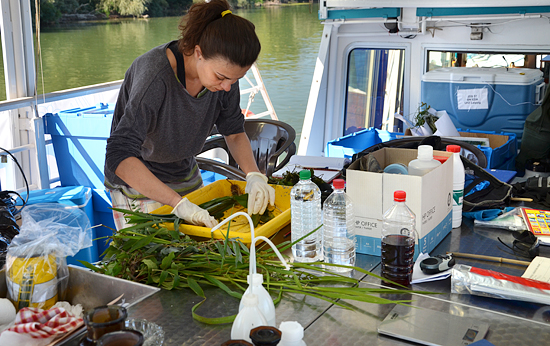

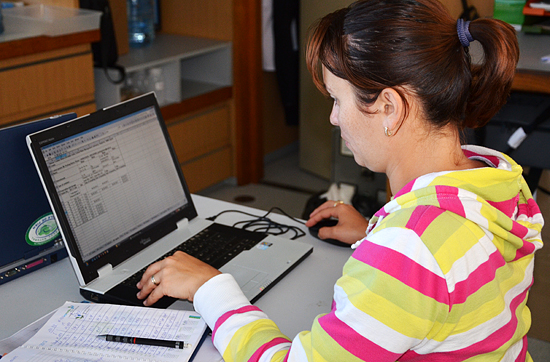
Impressions of the sampling and analysis work done on board of the JDS3 ships.
Turnu-Severin, 11 September 2013. The comprehensive sampling program carried out at each JDS3 site produces a wide range of diverse samples which are to be delivered to a number of laboratories throughout the Europe. As it was described earlier the sampling procedures at each site must be well coordinated not to forget taking any of the samples because there is no possibility of any re-sampling at a later stage as the ships have moved far away downstream the Danube. This is why a very careful evidence of all samples taken must be maintained regularly on board.
The responsibility for this very important task within the Core Team is with Florentina Dumitrache. Her major job is to deal with water sampling and with the on board physico-chemical analyses but next to this she continuously keeps a track of the sample flow through the ships. She has to make sure that up to 46 polyethylene, glass or aluminium bottles are available for storing the collected samples of water, sediments, fish and suspended particulate matter and that an evidence on all these samples is correctly put into the sample database. It is also essential that the collected samples are stored under proper conditions until shipping them off-board and that all of them are packed into a shipping container.
Twice a week the sample containers have to be collected from ships to ensure a rapid delivery of samples to their points of analysis and also to avoid a storage overload on ships. Florentina’s job must be done with full concentration and care as losing just one small bottle with few grams of sample would result into a blank point in the JDS3 database which would compromise the ambitious program of the survey.

Acipenser ruthenus or Sterlet, the smallest sturgeon species native to the Danube.
Orsova, 10 September 2013. New pictures from the fish team were submitted! Above, you see a speciment of the smallest sturegeon species native to the Danube, Acipenser ruthenus or "sterlet" in English. For more pictures, have a look at our fish gallery.
Kostolac, 8 September 2013. Day 27 of the JDS3 starts at 6:00 from Kostolac. From here, the ships travel 22 km to sample at Bazias. After completion, the ships will continue to travel downstream and land at Moldova Noua tonight. Meanwhile, a new story about scientific findings has reached us. Read more on an exciting discoveries of red algae below.
Red benthic algae found during JDS3
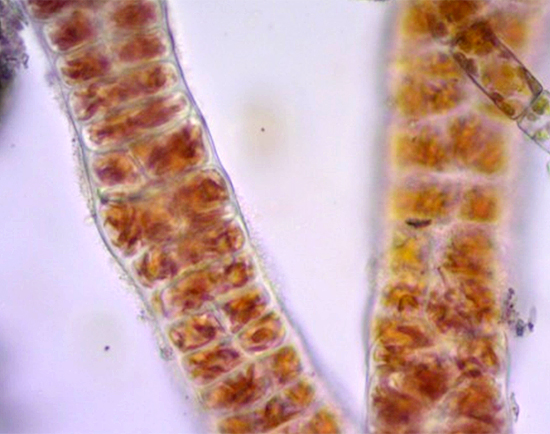
Fig. 1: Bangia artropurpurea from the Austrian stretch of the Danube.
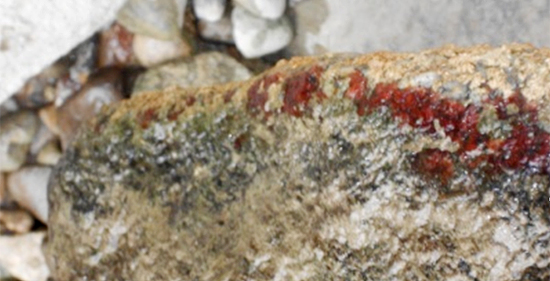
Fig. 2a: Hildebrandia rivularis from the upper stretch of the Danube.

Fig. 2b: Hildebrandia rivularis from the upper stretch of the Danube.
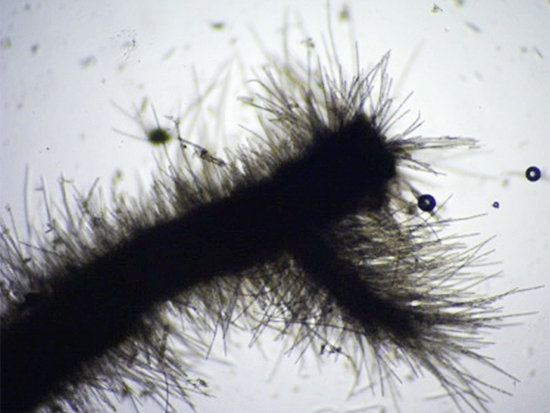
Fig. 3a: Thorea sp. from the confluence of the Sava River.
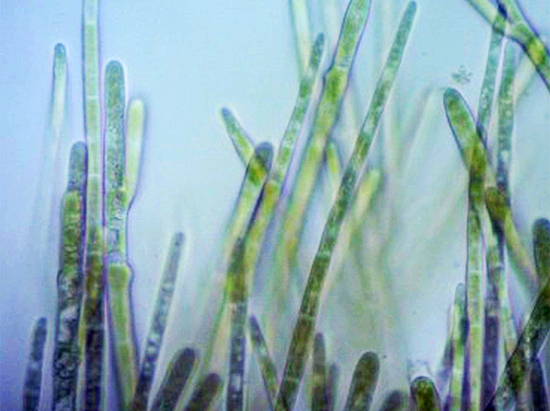
Fig. 3b: Thorea sp. from the confluence of the Sava River.
In the frame of the Joint Danube Survey 3 the phytobenthos is being investigated in the Danube River and its major tributaries. Beside benthic diatoms the non-diatom community is also analysed in terms of species diversity and the estimation of abundance. Jarmila Makovinska, the international expert on phytobenthos analysis having a tremendous experience from previous surveys, highlights that from the non-diatom community a number of red algae have been detected during the survey.
Among the more than 20 000 red algae that can be found in the world only a few hundred species live in the freshwater - in the rivers, the springs and or on the surface of the wet rocks or soil. Freshwater red algae are benthic macroscopic or microscopic plants. The name is based on predominance of the red pigments - phycoerythrin and phycocyanin. However some of the species can be blue-green, olive-green or brown-black.
So far, the Danube stretch of 1 484 km from Germany via Austria, Slovakia, Hungary, Croatia and Serbia has been investigated. There were three taxa of red algae found, Bangia artropurpurea, Hildebrandia rivularis and Thorea sp.
Bangia artropurpurea (ROTH) C. AGARDH (Figure 1) has been identified in the Austrian stretch of the Danube upstream Abwinden-Asten dam (2120 river km) as well as near Klosterneuburg (1942 river km). This algae is attached to the stones in the rivers with higher flow (rifles, weirs), where creates long brown-red filaments over the whole year.
Hildebrandia rivularis (LIEBM.) J. AGHARDH forms red or red-purple flat crusty patches on the rocks (Figure 2). Sometime patches look like a spots of blood on the stones. It can be found in the fast flowing rivers but it is especially wide spread in mountain streams. Its patches appear even on the underside of the stones. During the survey it has been recorded in the upper stretch of the Danube from Kelheim (Germany) up to Gabčíkovo (Slovakia) bringing an evidence on certain aspects of good water quality of this river stretch.
Macroscopic red algae Thorea sp. BORY was found by the colleague of Jarmila, Igor Stankovic who deals with macrophyte analysis during the survey. Thorea was found on the hard artificial substrate in the confluence of the Sava river into Danube. This algae looks like the brush, it has branched multiaxial olive-green filaments. It occurs quite rarely, usually in the mountains rivers and streams e.g., Thorea ramosissima or in the River Thames (Thorea hispida). Its presence in a large river like the Sava is quite uniqe.

Iron Gates/Porţile de Fier/Vaskapu/Železné vráta/Eisernes Tor/ Железни врата/Đerdap is a gorge on the River Danube.
The gorge lies between Romania in the north and Serbia in the south. At this point, the river separates the southern Carpathian Mountains from the northwestern foothills of the Balkan Mountains.
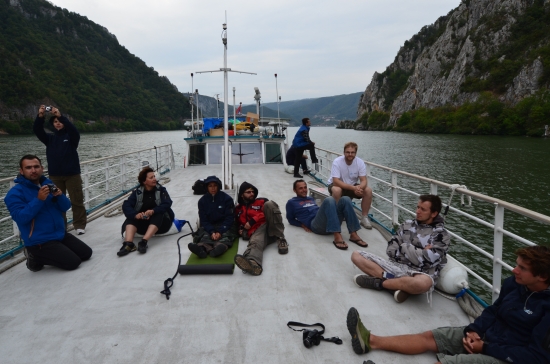
The core team members enjoyed the view from the deck of the ship Argus and made some photos of impressive gorge of the Iron Gates.
Moldova Noua, 9. September 2013. On their way to the sampling site 45 ( Orsova/Tekija) JDS3 expedition passed through the Iron Gates.
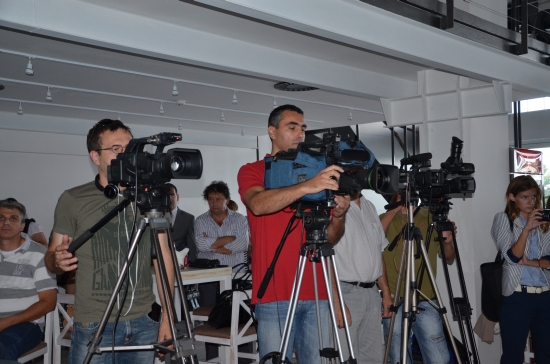
The Public Event drew a lot of media attention.
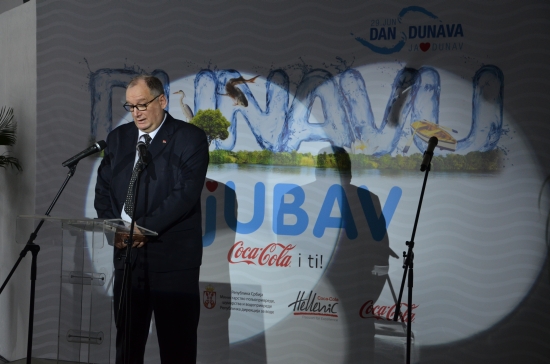
Miodrag Pjescic director of Directorate for Water of Republic of Serbia hosted public event in Belgrade, Serbia.
Belgrade, 5. September 2013. JDS3 Public event in Serbia was organised in Belgrade in club "Promenade". At the press conference spoke director of Directorate for Water of Republic of Serbia Miodrag Pjescic, Dragana MIlovanovic from Directorate for Water of Republic of Serbia, Executive Secretary of the ICPDR Ivan Zavadsky, Bela Csanyi Core Team Leader and local representative of the Coca-Cola. After the press conference all guests and media representatives had visited the ships and the laboratory on the ship Argus. You can find more pictures in our Serbia gallery.

Belgrade ahead! Tomorrow, a public event will be held at the confluence of Sava and Danube.
Belgrade, 4 September 2013. The little fleet of JDS3 ships is approaching Belgrade and will reach it around 5 pm today - a temporary homecoming for the Serbian Argus. The public event for Belgrade will take place tomorrow, see events for more details.
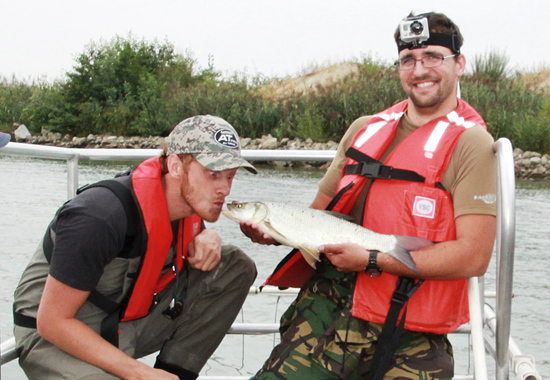
A fare-well kiss before the fish is released back into its Danubian home.
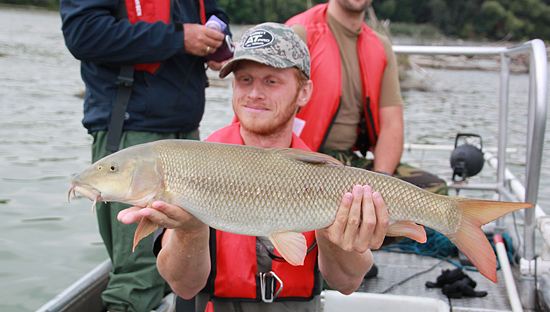
A large specimen of a barbel (Barbus barbus).
Novi Sad, 3 September 2013. The ships of the JDS have entered Serbia. Meanwhile, we have received some information from the fish team including a set of great pictures. Further updates will follow soon.
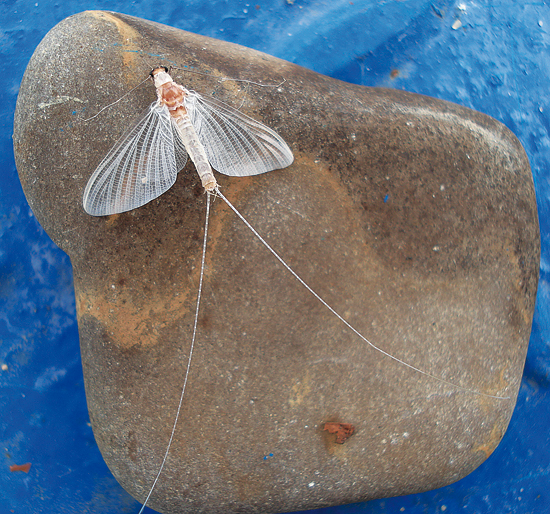
An adult mayfly Epiphoron virgo.
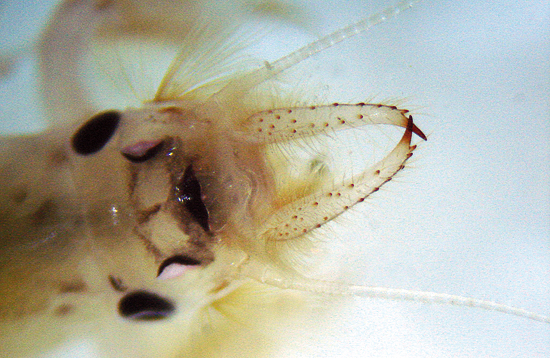
A mayfly larva under a microscope.
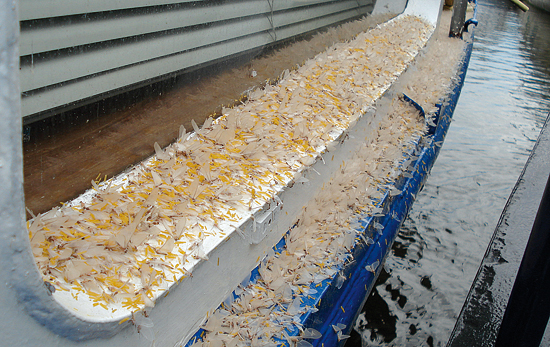
Adult mayflies on board of the JDS3 ships.
Backa Palanka, 2 September 2013. JDS3 core team members Patrick Leitner and Wolfram Graf provide us with some insights on the return of the mayfly Ephoron virgo.
The mayfly-species Ephoron virgo, a characteristic organism of large rivers, is one of many insects which live aquatic as larvae dwelling within the sediment of rivers while adults have wings and reproduce terrestrial. During an impressive swarming behaviour mating is performed shortly after which the adults perish. In contrary to this short imaginal life span larval development takes several month. Spectacular mass emergence (metamorphisis from larval to adult stages) of this specific large mayfly can be observed in the middle of August at the Danube and has been reported since the middle of the 18th century.
Bridges, ships and roads in the vicinity of the Danube are covered by millions of these insects which are attracted by artificial light. In former times the biomass of dead animals was so high that corpses were collected and used as food for swines and poultry. Mass emergences have not been observed for decades probably due to water pollution in the middle of the 20th century. Whether the species was totally lost and has recolonised the Danube recently or small populations survived in discrete refugia is debatable due to insufficient data. Besides pollution additionally hydromorphological degradation of the Danube further decreased suitable habitats of this species which is bound to a rather loose gravelly habitat.
During JDS2 the species was exclusively found at the German stretch between Geisling and Jochenstein in the year 2007. At JDS3 it was collected at the German stretch, and surprisingly at all sampled Slovakian JDS-sites downstream Gabcikovo and in most of the Hungarian stretch, but not in Austria. Impressive mass emergence of Ephoron virgo was observed only in Deggendorf and Esztergom/Sturovo but we just might have missed it as eye-catching swarming is timely restricted and also depends on weather conditions. Additionally Hungarian collegues reported on this phenomenon in the center of Budapest a few days before we arrived and obvious numbers of corpses were still visible on pontons and bridges. During the survey larvae and adults were detected also downstream Budapest indicating the existance of vital and continously connected populations over large stretches in the upper and middle Danube section.
The recovery of self-sustaining populations of this specific Danubian species can be contingently ascribed to a significantly improved overall habitat quality and nourishes the hope to document the return of other threatened species during JDS3 .

The press conference presented among others Deputy Minister of Agriculture Snježana Španjol,
General Manager of Hrvatske vode Ivica Plišić, and ICPDR Executive Secretary Ivan Zavadsky.
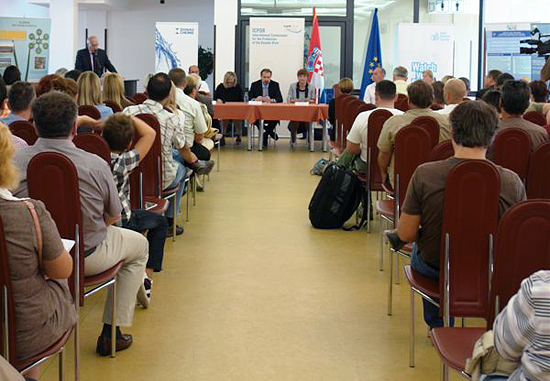
The press conference attracted a large number of local and national journalists. It was organised by the Ministry of Agriculture and Hrvatske Vode.

Crowds visiting the Istros at the public event in Vukovar.
Vukovar, 1 Septeber 2013. As the ships of the JDS3 reach the Croatian town of Vukovar, a press conference and public event are held. Pictures are presented in a specific photo gallery. Read here what our Croatian partners had to say about this highly successful activity with high-level representation from the new EU member state Croatia as well as internatioanl delegates:
"The biggest river expedition of the world in 2013– Joint Danube Survey 3 (JDS 3), which began on 13 August in Regensburg and, passing in the past weeks through Germany, Austria, Slovakia, and Hungary, entered the Croatian stretch of the Danube on 30 August 2013. Upon entering Croatia at Batina in the afternoon, representatives of Hrvatske vode greeted them aboard their ship and wished them a warm welcome. The expedition spent its first night in Croatia in Aljmaš, and the following day, on 31 August, sampling was conducted at two monitoring stations on the Danube and one at the Drava river mouth.
Samples of water, biota, and sediment were taken. Along with the international team, a national scientific team participated in the fish survey, led by Prof. Milorad Mrakovčić from the Faculty of Science, University of Zagreb. During the JDS 3 expedition in Croatia, the Meteorological and Hydrological Service also performed hydrological measurements. A public event and press conference, organized by the Ministry of Agriculture and Hrvatske vode, were held on 1 September at 10 a.m. in the Lav hotel in Vukovar. Introductory speeches were given by the Deputy Minister of Agriculture Snježana Španjol, General Manager of Hrvatske vode Ivica Plišić, and Executive Secretary of the International Commission for the Protection of the Danube River and expedition coordinator Ivan Zavadsky.
The speakers pointed out the significance of this research for establishment of the water status of the Danube and for cooperation of the Danube countries on the protection and sustainable use of the Danube under the International Commission for the Protection of the Danube River. The hosts, Vukovar-Srijem County prefect Božo Galić and Deputy Mayor of Vukovar Danijela Stanković also greeted the guests. After the introductory speeches by the organizers and the hosts, Core Team Leader for JDS 3 Bela Csanyi presented the expedition and invited the guests and journalists to visit the research vessels Argus and Istros, moored near the Lav hotel, and get acquainted with the work of the international JDS 3 team."
Non-lethal electrofishing is used to sample fish.
Fish are measured and assessed and then released back into the Danube.
Baja, 30 August 2013. The JDS3 ships are travelling towards the border to Croatia, where the next public event will be held in Vukovar tomorrow. Meanwhile, we have received a few video clips which demonstrate nicely how the fish team samples fish using non-lethal electrofishing methods.
Kalocsa, 29 August 2013. Today, the ships have started at 06:00 to travel 17 km upstream to Paks for sampling at river kilometre 1533. Later, they will travel 52 km downstream to Baja and sample at river kilometre 1481 before landing in Baja to close the day in the evening. As we anticipate to get data from the fish team for the blog, we thought it is a good opportunity to publish the next three profiles of core team members. Meet Claudia Nagy of Romania, Patrick Leitner of Austria and Stoimir Kolarevic of Serbia.
Budapest, 28 August 2013. Not only conventional media, also bloggers take notice in the Joint Danube Survey. We noticed a very nice example with great pictures and detailed texts here.

Hungary's State Secretary for Water Peter Kovacs, who is also head of the Hungarian delegation to the ICPDR, and ICPDR Executive Secretary Ivan Zavadsky at the public event earlier today.
Budapest, 27 August 2013. The 4th public event in Budapest drew the crowds to the banks of Hungary's capital today. You can find more pictures in our Hungary gallery.

2-metre long catfish (Silurus glanis) caught today.
Budapest, 26 August 2013. The fish team reports quite a catch: a 2 metre long catfish (Silurus glanis)! Photo evidence is provided above. You can learn more about this remarkable species of fish here.

Data on E.coli contamination at different sampling sites along the course of JDS3 is showing interesting details.
Sturovo, 25 August 2013. The first results are officially out! The microbiology team has prepared a report with a surprising detail which we can share here in the news blog for the first time:
"In contrast to JDS 1 and JDS 2 microbiological sampling was performed not only in the middle of the Danube, but also at the left and right river side. It had been observed that the water in the middle of the river was often unaffected by expected high concentrations of microbial faecal indicator bacteria, entering the Danube from wastewater, wastewater treatment plants, or polluted tributaries. Thus, for JDS 3, at some sampling sites, significantly higher concentrations at the river sides were expected.
E.coli and Enterococci as faecal indicators were chosen for analysis of faecal pollution, according the EU Bathing Water Directive. In addition, total Coliforms were determined. As the results of the first 19 sampling sites (including the additional microbiological sampling sites Inn and downstream Vienna) show, at specific sites, markedly higher concentrations of E.coli were observed at the left (Kelheim, Oberloiben) or right river side (downstream Vienna until Hainburg and Kliszka Nema)."
You can download and read the full report as a PDF here.

Sampling at a JDS3 sampling site (this and the three pictures below were taken in Germany and Austria last week, the ships are now downstream of Gabcikovo).
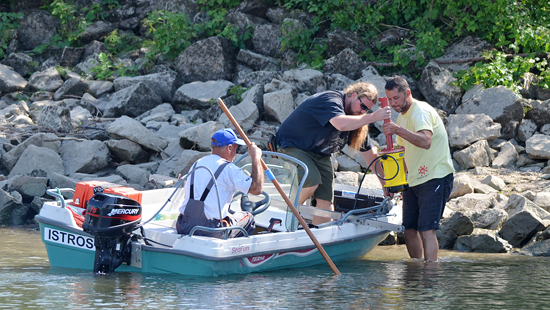
Some sampling and monitoring is carried out via smaller boats transported on the ships.
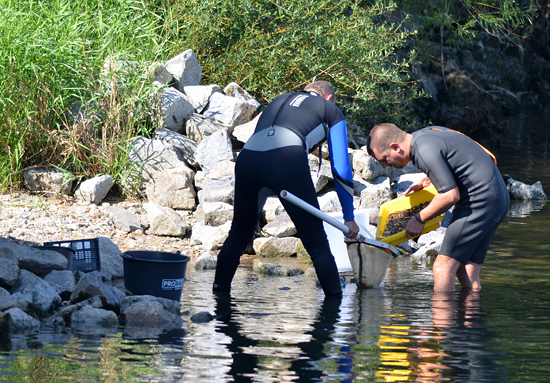
Collection of marco-zoobenthos (invertebrate animals that can be seen without a microscope and which live attached to the ground).

A boat on a sampling mission.
Komarno, 24 August 2013. This weekend comes with an schedule of intense sampling. A good opportunity for JDS3 project manager Igor Liska to write a blog entry on what exactly is happening during these sampling stops of the ships.
Sampling Sites: What happens there?
The ambitious program of the JDS3 requires a large number of analyses to be performed investigating water, sediments, suspended particulate matter, sediments and biota. This necessitates collecting diverse samples from each sampling site. Four hours have been planned to accomplish this job at a particular site covering the whole profile of the river. To manage finishing of the sampling plan within a given time slot it is essential that the activities of the Core Team members have been well prepared and orchestrated and then fine-tuned during the initial sampling performances.
Three boats are deployed from the Argus and Istros at each site to transfer the monitoring experts where needed. The macrophyte researcher has to be brought to the shore by the first boat as quickly as possible because he has to trawl three kilometres on both left and right bank assessing plants occurrence and diversity. Along with him the expert sampling phytobenthos as well as those performing multihabitat sampling of benthic macroinvertebrates are to be transported to the shore to start with their job. Afterwards the first boat is used for repositioning of all these experts along the sampling site as required.
The second boat is used to collect water and sediment samples for the chemical analysis. Simultaneously, water for diverse microbiological investigations is sampled and delivered to the laboratory on the Argus ship where faecal indicators (total coliforms, E.coli, enterococci, presumptive Clostridium perfringens) are analyzed. A more comprehensive microbiological analysis will be done later in the laboratories. Having accomplished this first sampling step, zooplankton sampling and bottom dredging for benthic macroinvertebrates on five cross-sectional profiles in the river is carried out.
The third boat is used by hydromorphology experts to make a detailed characterization of the sampling site and to collect river bed material and perform measurements of flow velocity, river discharge, suspended sediment and of water level slope and fluctuation. Water for the analysis of phytoplankton is sampled directly from the Argus.
While the teams in their boats are executing their job, thousands of liters of river water are being pumped on the Argus through the special devices to collect the suspended particulate material which will be analyzed later for hazardous substances and also to trap by various sorbents the chemical substances occurring in the water to be able to detect even the extremely small amounts of any toxic pollutants that might be harmful to the humans or biota.
It is of utmost importance that all this separate sample collecting actions are properly concerted and must fit into the four-hours time slot not to jeopardize the overall time plan of the survey. After practicizing this sampling program at the first few sites it has been fine-tuned and brought to an operational excellence but given the uncertainty always present in a field work an adaptive management has to be applied whenever necessary.
In addition to the above mentioned activities an electrofishing boat is used by the fish team to catch the fish species in a particular littoral habitats both during the day and over the night. The river bottom is sampled for fish from another boat using an electrified bottom trawler net (deep water fishing). It has to be emphasized here that after putting down the needed data all fish would stay alive and is returned back to water.
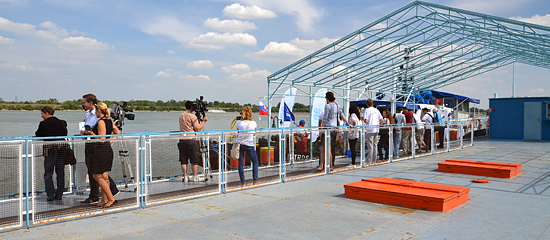
Journalists and crowds gather in anticipation of the JDS3 ships.
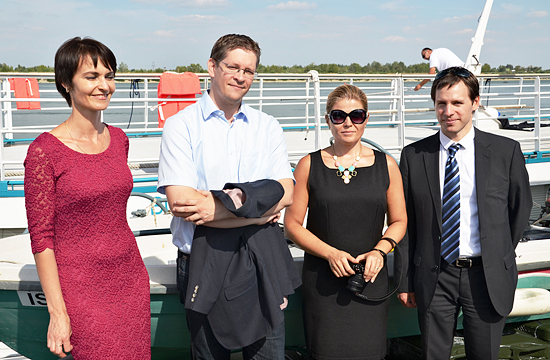
Representatives of the Slovak Ministry of the Environmnet and Donauchemie, a corporate partner of JDS3.
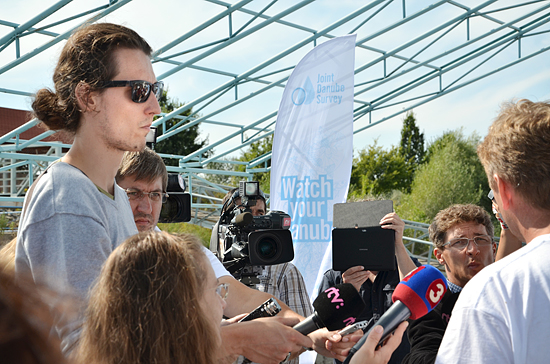
Journalists interviewing the technical coordinator Jaroslav Slobodnik.
Gabcikovo, 22 August 2013. JDS3 is making headlines in Slovakia: several TV stations have participated in the public event at Gabcikovo hydropower plant. Note for example this TV report, starting at minute 16:45. You can watch pictures from the public event at the Slovakia gallery.
Bratislava, 22 August 2013. The JDS3 ships have passed the Slovak capital and are on their way towards Gabčíkovo, where the next public event will take place today. Whilst waiting for updates and photographs from this occasion, we will launch a series that will accompany the JDS3 until the end of the survey: the publication of profiles of individual core team members. The scientists of the international core team act as ambassadors for the Danube; with their academic interests, national background and personal stories to tell, they can help to connect people to their work. We start the series with three senior members of the team: Bela Csanyi (HU), Martin Dokulil (AT) and Momir Paunovic (RS). Other profiles will follow soon and will be announced here in the blog, too.
Note: You will find the complete Austrian photo gallery here with more pictures and events included.
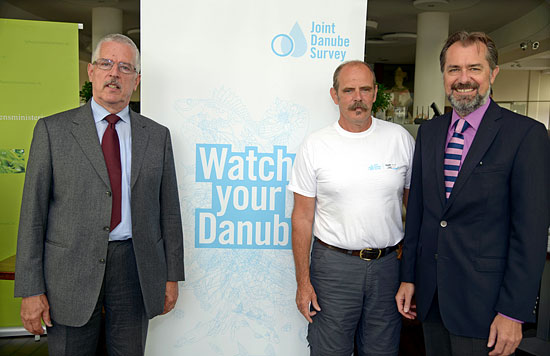
Austria's Water Director Wilfried Schimon, JDS3 Core Team Leader Bela Csanyi
and ICPDR Executive Secretary Ivan Zavadsky.
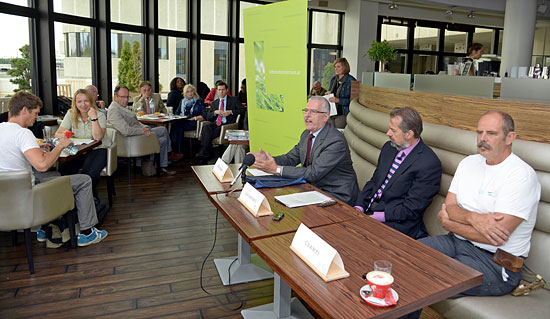
Journalists, representatives from Danubeparks, corporate partners and visitors follow the press conference.

Franz Geiger of Donauchemie, a corporate sponsor of JDS3, in discussion with the
Austrian Head of Delegation Karl Schwaiger (left) and Water Director Wilfried Schimon (right).
Vienna, 21 August 2013. The Austrian Ministry of the Environment has provided the photographs of yesterday's press conference and sampling. We arranged them in a photo gallery, and present a few more above.
The Argus and Istros leaving Vienna.
Vienna, 20 August 2013. The public event and press conference in Austria was held. Water Director Wilfried Schimon, Executive Secretary Ivan Zavadsky and Core Team Leader Bela Csanyi presented facts and figures and replied to questions asked by the journalists. As representatives for JDS3 corporate sponsors, Franz Geiger and Paul Schaller of Donauchemie AG attended the public event.

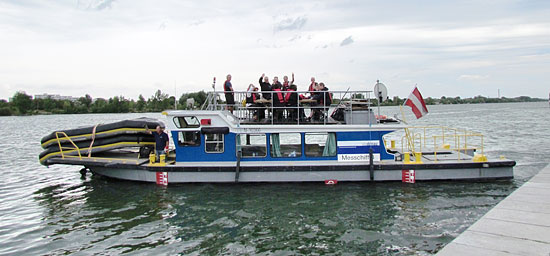
A group from National Park Donauauen / Danubeparks is accompanying JDS3 via a 3-day paddling and camping extravaganza.
A delegation from the Danubeparks network presented their findings on monitoring the breeding pairs of sand martins and little ringed plovers, two bird species that serve as important indicators for the river morphology. The data collection for this had already been done in spring, as it had to be matched with the breeding season of these two species of birds. Further information on this monitoring effort and the results can be downloaded in a fact sheet.
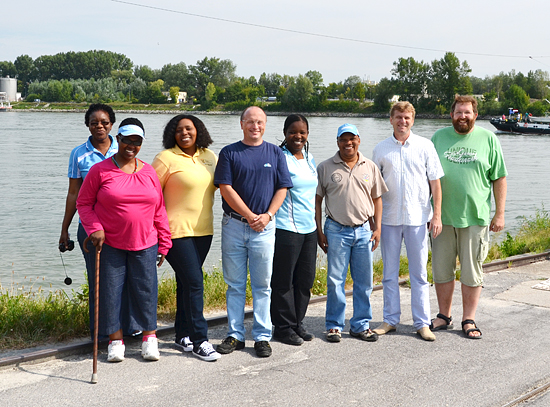
Representatives from Orasecom countries and secretariat meet Igor Liska (ICPDR Secretariat) and Franz Wagner (AT).
Special thanks go also to a delegation from the Orange-Senqu River Commission (ORASECOM - more on the visitors in a separate blog entry) and a group of paddling enthusiasts coordinated by Danubeparks, who made the occasion a true "public event". The ships, which you can see departing from Vienna in the video above, are now on their way to Wildungsmauer, where the next sampling stop will be done.
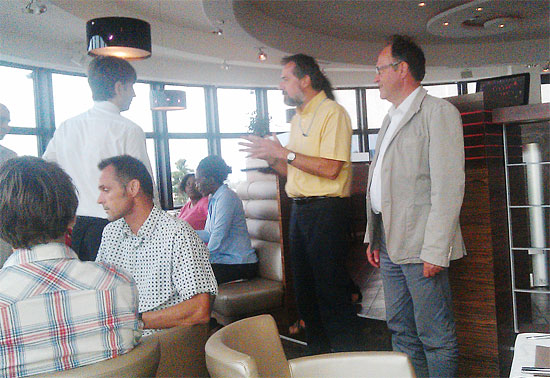
ES Ivan Zavadsky and Austrian HoD Karl Schwaiger expressing their thanks
to the JDS3 core team at a dinner hosted by Austria in Vienna.
Vienna, 19 August 2013. The Core Team made it to Vienna. After a short period of leisure time, they gathered at "The View", a restaurant, where Austria has invited them for dinner. The Austrian Head of Delegation to the ICPDR, Karl Schwaiger, welcomes the participants of the JDS. ICPDR Executive Secretary Ivan Zavadsky expresses his appreciation for the scientists before the informal part with fine food, drinks and good company ends the day with discussions over tomorrow's public event.
Upper and Lower Austria, 17/18 August 2013. A busy weekend for the JDS3 core team: On Saturday, they start from Passau at 06:00 travelling 21 km downstream to Jochenstein for a first set of sampling. From Jochenstein, they continuedfurther 84 km to ”Upstream dam Abwinden-Asten”, another sampling location. After this second sampling stop, they returned 10 km back upstream to Linz for landing overnight at approximately 23:00. On Sunday, the ships set off from Linz at 06:00 to travel a full 122 km downstream to reach Oberloiben before 14:00. Sampling takes place before they continue 10 km downstream to Krems where they moore at 20:00. Monday will be less stressful, with sampling only int he morning and a free afternoon to recover in Vienna. Pictures will be posted here shortly.
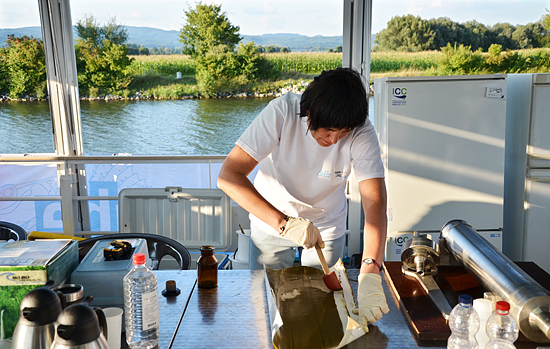
Handling suspended particulate matter on board of the JDS3 ships.
Passau, 16 August 2013. The sampling routine as started as the ships of the Joint Danube Survey are going down from Regensburg via Deggendorf towards Passau. This morning at 6:00 a.m., the ships set off 27 km downstream to Mühlau. Around noon, the survey reached Passau right at the border to Austria, where the Core Team has a free afternoon to relax, before heading into a busy weekend of sampling in Upper Austria.

Sampling downstream of Regensburg is supported by small boats and local scientists travelling by car.
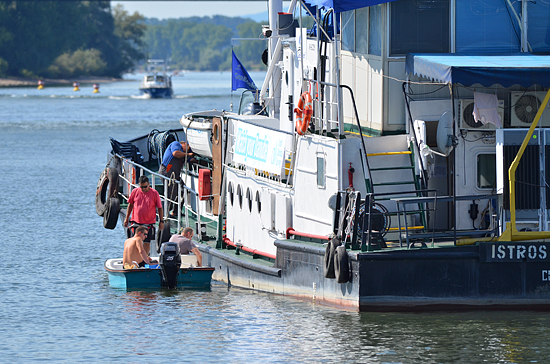
The Istros downstream of Regensburg.

Analysing samples at the shores of the Danube near Deggendorf.
Regensburg and downstream area, 15 August 2013. Sampling at the first two JDS3 sites was different from the rest of the survey. Since the Danube is relatively small at these sites, the Argus and the Istros did not navigate there and the sampling was organized by the Bavarian national team. It provided its cars and small boats as well as the sampling equipment.
The organization of sampling upstream Regensburg as well as of the overall logistics in the territory of Germany has been perfectly managed by Manfred Sengl, JDS3 National Coordinator from the Bavarian Environment Agency. He has been supported by Stephanie Kexel from the Regional Water Agency in Regensburg in ensuring the transfer of the Core Team to both sampling sites, organizing accommodation for a number of JDS3 experts, helping with the local transport and responding rapidly to several last-minute requests for purchasing the missing spare parts.
The field work of the Core Team has been supported mainly by Gunther Seitz who secured a boat for the hydromorphological team and carried out a parallel biological measurements, Peter Gstottl who sampled the suspended matter and Jorg Brandner with Christoph Mayr collecting fish samples at the first two sampling sites. The excellent support provided by the Bavarian colleagues was backed up by both the Bavarian State Ministry for the Environment and Public Health (Andreas Kolbinger) and the Federal Ministry for the Environment, Nature Conservation and Nuclear Safety (Knut Beyer).
Note: You will find the complete German photo gallery here with more pictures and events included.
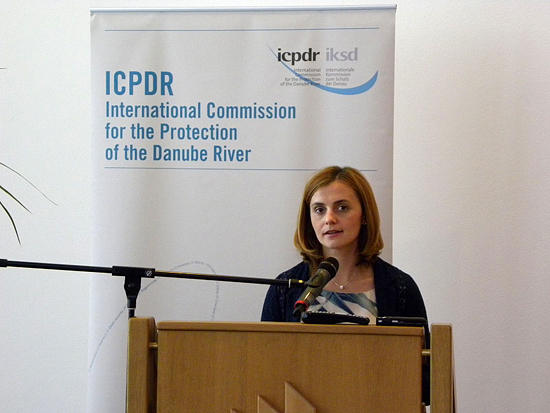
ICPDR President Ermina Salkičević-Dizdarević at her JDS3 opening speech.
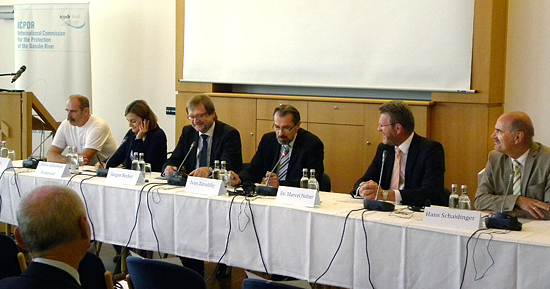
From left to right: Bela Csany (Scientific Core Team); Ermina Salkičević-Dizdarević (ICPDR President); Jürgen Becker (State Secretary for the Environment, Germany); Ivan Zavadsky (ICPDR Executive Secretary);
Marcel Huber (State Minister for the Environment, Bavaria); Hans Schaidinger (Mayor Regensburg)

The Argus in its fashionable JDS3-outfit, ready to watch the Danube.

Marcel Huber (State Minister for the Environment, Bavaria) with journalists (foreground) and JDS3 beach flag (background).
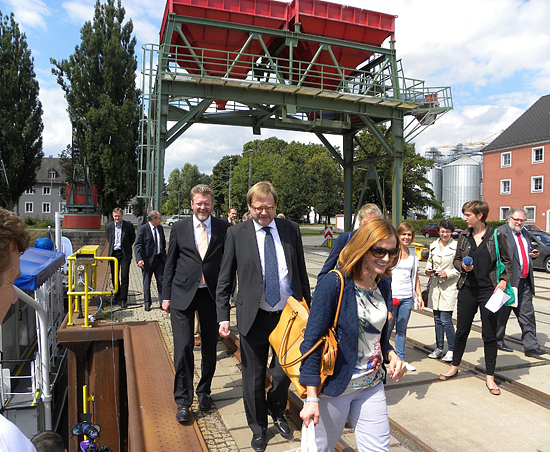
JDS3 dignataries on their way to meet the scientists on board.
Regensburg, 14 August 2013. The launch event for the Joint Danube Survey 3 was held in the port of Regensburg today. ICPDR President Ermina Salkičević-Dizdarević delivered a speech that you can read here, in which she was joint by Ivan Zavadsky (ICPDR Executive Secretary), Jürgen Becker (State Secretary, Federal Ministry for the Environment, Nature Conservation and Nuclear Safety), Marcel Huber (State Minister for the Environment and Health of Bavaria) and Hans Schaidinger (Principal Mayor of Regensburg). You can see a selection of photos above or a full gallery here. The ships are now "setting sail" and start the sampling work. You can also read the German press release here.
Later today, the "Bayrischer Rundfunk" broadcasted a short video report on JDS3, which is also available online.
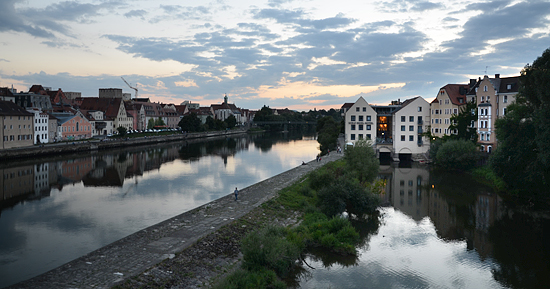
Morning dawns over the Medieval city centre of Regensburg: the new day marks the launch of JDS3.
Regensburg, 13 August 2013. The Joint Danube Survey 3 has officially started: the core team is ready to take up its work, ICPDR President Ermina Salkičević-Dizdarević and ICPDR Executive Secretary Ivan Zavadsky are in Regensburg. Tomorrow, they will attend the launch event with representatives of the city of Regensburg and the state of Bavaria. The first international press release was published and launched world-wide via the UN Information Service - with first responses from national broadcasts already coming in. Fingers crossed for a fruitful journey and many interesting results for this Joint Danube Survey 3!
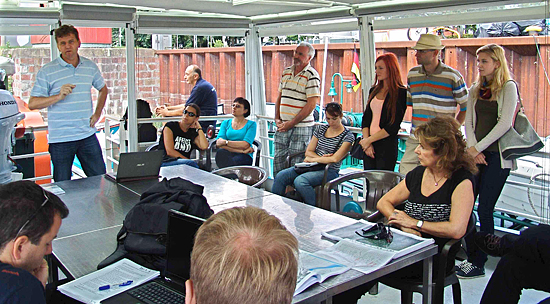
JDS3 Technical Coordinator Jaroslav Slobodnik briefing the core team at the JDS3 kick-off meeting in Regensburg.
Regensburg, 12 August 2013. The "kick-off meeting" was conveyed in Regensburg today. The members of the JDS3 core team, project managers and national coordinators came together to inspect the ships "Argus" and "Istros" and discuss the course of the survey. Core team members were equipped with the branded jackets, T-shirts and baseball hats, individual tasks and duties of core team and crew were presented. For the website, we have started a photo gallery for JDS3 impressions from Germany. It will be extended as we receive more pictures. With the first public event to be held on the 14th, we expect lots of more photographs to come - they will be presented here on danubesurvey.org in country-themed galleries with Germany as the first of the 10 national destinations. Here you can follow the kick-off meeting from the perspective of JDS3 project manager Igor Liska:
"The Launch Day"
It is 12 August 2013. The tropical heat that Central Europe was suffering from a week ago has turned into a mild, pleasant summer. For all people involved in JDS3, however, the heat is on. The JDS3 Core Team members and the supporting experts meet with the Argus and Istros ships in Regensburg, an ancient Bavarian town having its long history closely connected with the Danube. The harbour of Regensburg serves for the third time as the starting point of the Joint Danube Survey. But before the ships will set off, the installation of all necessary equipment on board is needed as well as checking that all measuring devices and other equipment would function perfectly. It is not only wet sieving machines, microscopes, autoclaves and special detection devices which must be put into operation.
There is a continuous flow centrifuge needed for collecting suspended particulate matter (sediments flowing in the water) from thousands of litres of Danube water at each site. Effect-based monitoring of low concentrations of toxic pollutants in the Danube requires significant pre-concentration and extraction of large water volumes. A newly developed mobile large-volume extraction unit has therefore been installed on the Argus applying a sequence of sorbents for the optimized extraction of a broad scale of contaminants. Hydromorphological investigations of the Danube will include various measurements of water depths and flow velocity.
For this purpose an Acoustic Doppler Current Profiler device for measuring three dimensional flow velocities will be used during JDS3 and it has to be checked before setting-off. Preparing ships for the survey is not only a task for the Core Team, but also the crews of the ships who have to make sure that the scientific work on board will not interfere with the navigation of the ship. The crews of both Argus and Istros have been very helpful to the Core Team in making all necessary arrangements on board. Very active support provided by Tomislav Andjic, the technician from the Argus, fixing all technical problems which appeared during installation of the equipment has been highly appreciated.
The kick-off meeting of the Core Team starts on Monday at 12:00 sharp and it is a good sign that all experts from around the Danube basin (and some even from beyond) could make it for this meeting on-time. At this meeting, the team has to make the final agreements on the operational procedures to be followed at each sampling site. The activities of all experts have to be properly synchronized because during the four hours the ships will stay at each sampling site, numerous measuring and sampling actions have to be taken in parallel. To accomplish those actions, excellent cooperation and coordination between Core Team members is essential. This must be based on proper planning.
Danube Basin, 9 August 2013. The JDS3 core team members and project managers are getting ready for next week's kick-off meeting in Regensburg, Germany. Meanwhile, we thought before the start of JDS3, we may want to have a closer look at the history of the Joint Danube Survey. You may know that the first JDS was held in 2001 - but did you know that there is a 19 minute documentary that tells you more about this first survey under ICPDR auspices? As an appetiser for JDS3, we have uploaded this now almost historic video on our YouTube channel and you can watch it below.
More on the Joint Danube Survey 1 (JDS1) of 2001
The six-week long Joint Danube Survey 1 (JDS1) was launched on August 14, 2001 from Regensburg, Germany. It was the first expedition to ensure a homogeneous set of data about water quality with a high comparability of results for much of the Danube River (2,581 km), and to identify and confirm specific pollution sources.
The expedition was organized by the ICPDR and included an international team of ten scientists from Germany, Austria, Slovakia, Hungary, Yugoslavia, Bulgaria and Romania. The team was on-board two ships -- the then German (now Serbian) Argus and the Hungarian Széchényi. Each participating country further provided in-kind contributions through national teams of experts who worked with the international JDS experts on their national stretch of the Danube. Funded by Germany and Austria, the overall cost of the expedition was over 556,000 Euros.
Hundreds of samples were collected from selected river cross-sections at 98 sites. Over 140 different parameters were tested including chemical pollutants, biological parameters, aquatic flora and fauna and bacteriological indicators. Some parameters (e.g. pH) were measured on-board the laboratory ship Argus immediately after sampling. The rest of the samples were carefully preserved, stored and sent to laboratories.
The JDS1 produced a reliable and consolidated picture of the water quality of the Danube and its major tributaries in terms of chemical, biological and micro-biological parameters. Positive findings included high levels of biodiversity and rare species. Negative results included concern over organic and microbiological pollution, heavy metals, oil from ships, pesticides and chemicals. Significant awareness was raised about the Danube and the need for pollution reduction measures through major media and public events held at many locations visited by the ships.
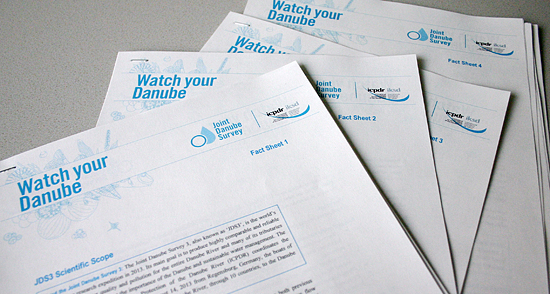
The fact sheets for JDS3 give in-depth information on specific topics.
Danube Basin, 8 August 2013. The JDS3 Fact Sheets were uploaded to the website today. What are they? A series of eight publications of approximately three to four pages each, the fact sheets provide in-depth information on specific topics or aspects of JDS3. While the "JDS 3 Flyer" provides an overview on JDS3 for the general public, the fact sheets target an audience with a deeper, more technical interest.
Fact Sheet 1 is on the scientific objectives of JDS3; Fact Sheet 2 explains how JDS3 is embedded into the legal environment created by the EU Water Framework Directive and the River Basin Management in the Danube Basin; Fact Sheets 3, 4, 5 and 6 are dedicated to the four "Significant Water Management Issues" (organic, nutriend and hazardous substance pollution as well as hydromorphological alterations); Fact Sheet 7 explains how the ICPDR and its contracting parties work on monitoring, assessment and other "metering" exercises at and around the Danube; and Fact Sheet 8 looks at JDS history and how other regions in the world have modelled research expeditions after the Joint Danube Surveys.
You can download all Fact Sheets as PDF from the front page of www.danubesurvey.org.
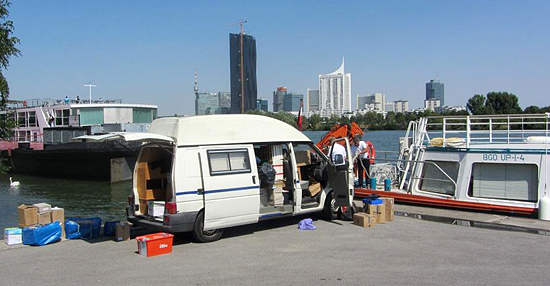
The minivan bears publications and other vital items for JDS3. In the background you see the Vienna International Centre, where the ICPDR Secretariat is located.

Working hard at nearly 40 degrees and still smiling: Franz Wagner demonstrating the JDS3 spirit.
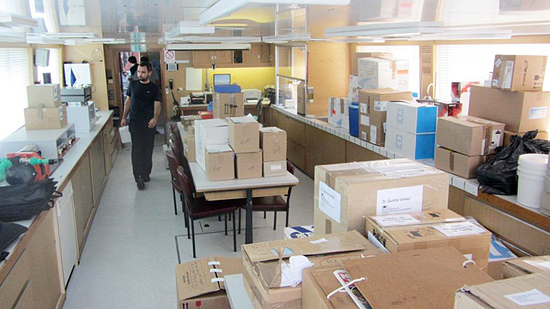
The Argus after being charged with publications, scientific instruments and other items.
Vienna, 7 August 2013. The loading of Argus with scientific instruments, publications and branding items for JDS3 was successfully completed in Vienna today. Over 39 degrees Celsius did not prevent Helena Mühlmann and Franz Wagner of the Ministry of the Environment with assistance from crew and helpers to carry box after box. The Argus moored in Vienna for only two hours, forcing the team to time its actions precisely. The Argus then continued its journey upstream towards Regensburg, where JDS3 will be launched next week.
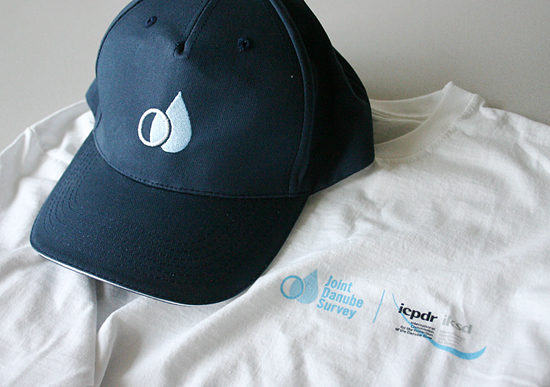
Vienna, 5 August 2013. The branding items are complete: baseball hats, T-shirts and jackets will ensure a uniform appearance of the scientific core team, beach flags and banners will help the ships to stand out. The branding items will be disseminated prior to the launch event in Regensburg next week. Everybody involved with JDS3 is already highly excited - only a few more days to go before the start!
Vienna, 8 July 2013. The official flyer of "Joint Danube Survey 3" is finalised. The layout follows the sujets of JDS2 in a contemporary context. It contains important information on background, objectives and methods of JDS3 at a glance and will be printed in an edition of 4000 copies. The flyers will be disseminated at the public events, can be ordered at the ICPDR Secretariat or downloaded here.
Vienna, 27/28 June 2013. A JDS3 coordination meeting is held at the Austrian Federal Ministry of Agriculture, Forestry, Environment and Water Management. Susanne Brandstetter presents the communication strategy to the core team and some people involved with project management. An outline for the next steps is discussed, the focus of the meeting is on techncial aspects of JDS3 and organisational matters.
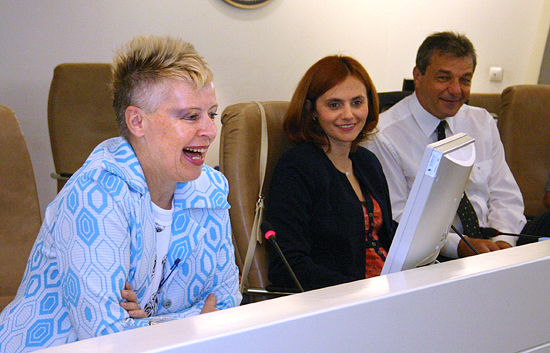
PP EG Chairperson Susanne Brandsetter, ICPDR President Ermina Salkičević-Dizdarević and ES Philip Weller discuss JDS3 communication in Sarajevo.
Sarajevo, 19 June 2013. The Standing Working Group of the ICPDR sets JDS3 on the right course. Important decisions are made related to financing and managerial procedures, but also to communication - the JDS3 communication strategy is presented and adopted at this meeting of the ICPDR.
Links
-
Website of the International Commission for the Protection of the Danube River.

